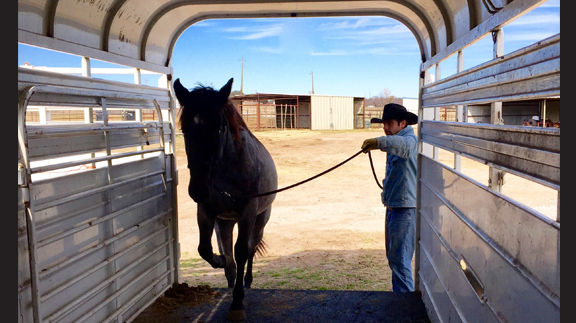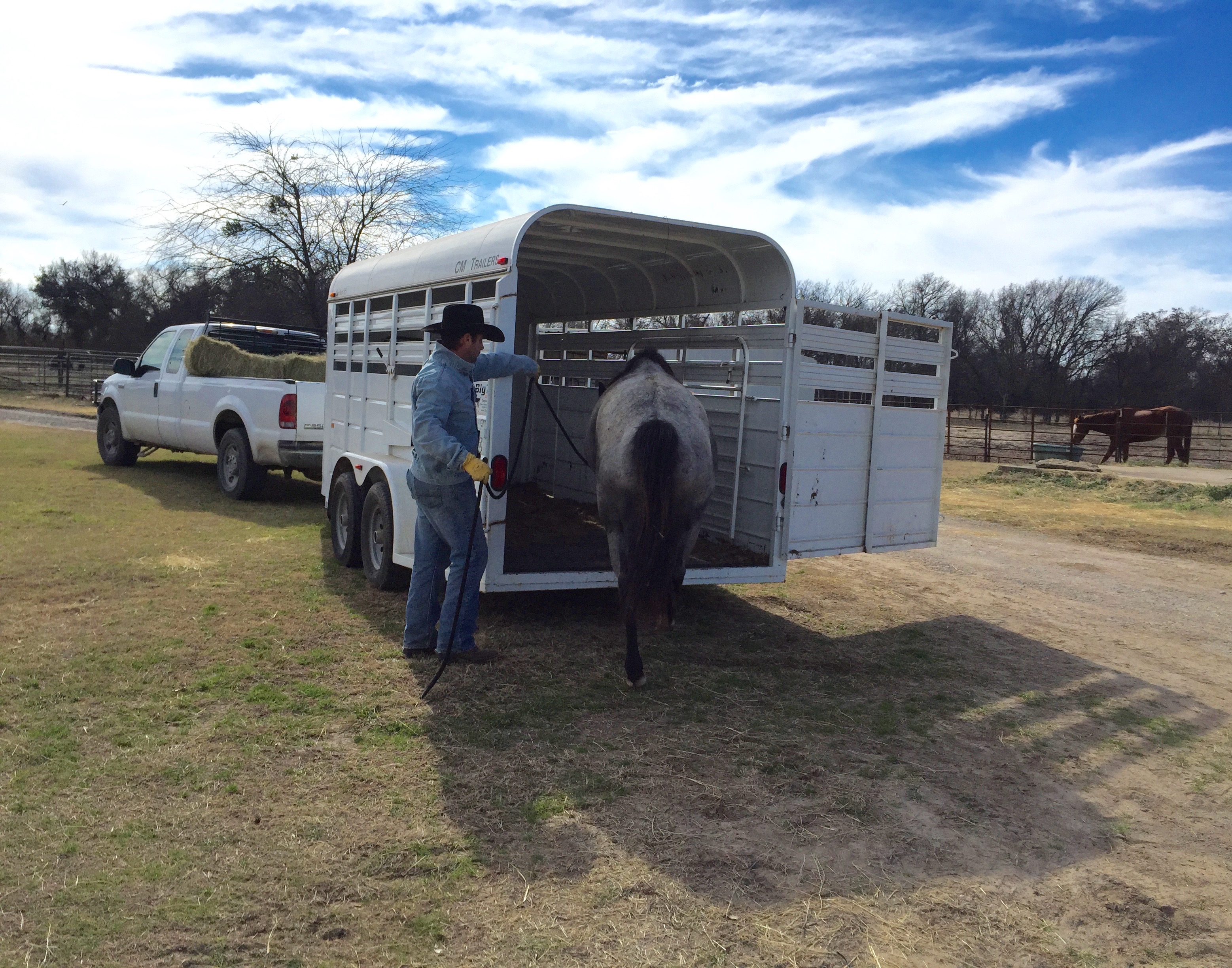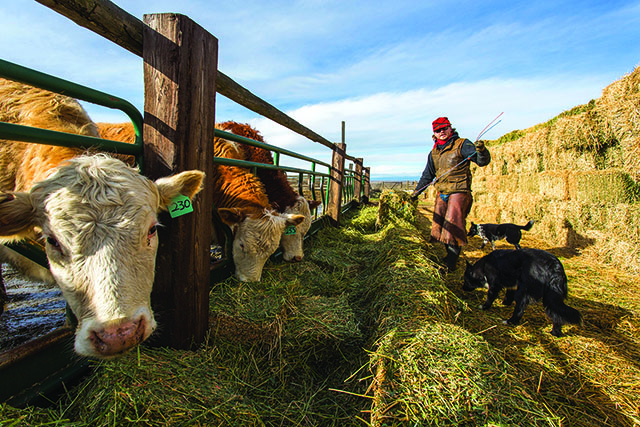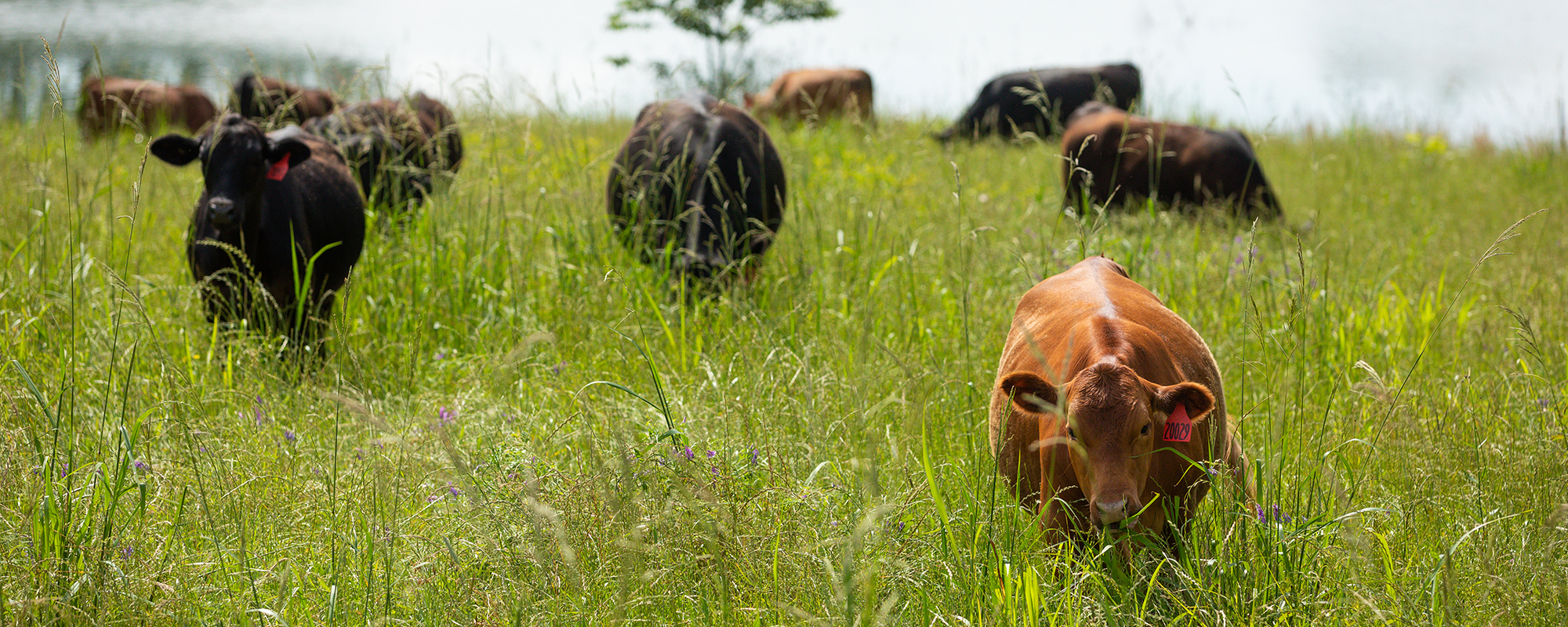HOME
Trailer loading- The Natural Horseman

One of the easiest and most difficult things to do with horses is the infamous, somewhat elusive, potentially dangerous for you and the horse- the one, the only trailer loading. We all have to learn to do it at some point if you are going to reach any kind of horsemanship level. Whether you are hauling horses to the big show, picking up a new baby or most importantly- getting a horse to the vet as quickly as possible. It also gives us freedom with our horses. None of that is possible if you can’t get your horse in the trailer.
About Twenty years ago…
We were in a hurry to get the sorrel colt down the road to a roping event. The colt was strong and still carried that wild look in his eyes. We were running late and the rest of the herd was loaded. We loaded him in the back of the stock trailer as to follow the rest of his herd friends. This had worked a time or two before with a little motivation from whipping the horse from behind.
But today would be a big eye opener for me in the art of horse training. I was with some top hands who I looked up to and followed on their every word. Today the sorrel colt did not want to load and daylight was burning. So the whipping, yelling and frustration was rising like a tide, like a fast coming tsunami. The colt started to lash out at the whips and pressure by kicking out, all three of us were shoving on his rippling muscles trying to push him in, endangering ourselves and sending the colt into complete survival mode. One of the hands said ‘you won’t best me you son of a gun”. And he ran a lariat through the halter and up through the front of the trailer. He gave me the tail to pull on and the other whipped from behind. I had seen this done before but without the ferocious fight. I knew everything inside me was telling me that the horse was scared and we weren’t getting anywhere. But I followed my cohorts and the gang leader just like we were robbing the pacific railroad and I was told to keep my gun on the conductor. The gelding was now covered in sweat and legs were bleeding from bouncing off the back of the trailer. Finally the colt seemed to give in and half way entered the trailer. But an ill advised whip and the horse reared and hit his head in the trailer, ripping the rope out, ripping the skin off my hands, falling backwards and crashing into the ground.
The horse was on the ground helpless, scared to get up, with blood on his head. I knew this couldn’t be the right way. But embarrassingly so, I didn’t want my peers to see I was a sensitive man and implore them to think of me as less of a cowboy, so I said nothing.
The colt was fine later, but these are situations that I look back on and wish I would have known then what I know now. How I may have been able to help the situation.
I am proud to say that over twenty years later, I have learned, new methods.I have loaded hundreds of horses that were scared to load or had never been loaded and have not used force to load a single horse. I now use pressure and release techniques to make the wrong thing difficult which is used when the horse doesn’t step forward towards the trailer. This takes timing and patience. It is really the simplest technique ever. We just want to make the trailer a place of comfort for the horse and we do that by making him work outside the trailer by moving his feet- lunging, rollbacks, backing, you name it and when he goes towards the trailer we release the pressure. With a little patience they can learn to load. Over time they will beg you to go into the trailer.

It is great to teach the horse how to be sent into the trailer along with being able to lead them into it. (Photo courtesy of Amanda Stevens)
I want to issue a challenge to all horsemen and horsewomen out there- to learn how to load your horses quietly and smoothly, teaching them to want to be in the trailer. Don’t wait until you have to go somewhere. Work on it with patience and grace and when you have the time that it takes.
Post your best trailer loading moment on our Facebook page at Stevens Natural Horsemanship and we will share it with all of our friends.
https://www.facebook.com/StevensNaturalHorsemanship/videos/411193645576520/
HOME
Farm and Ranch Injuries

By Barry Whitworth, DVM
In January, I attended the Oklahoma Veterinary Conference. While waiting for one of the sessions to start, a classmate of mine commented how many of the attendees walk with a limp, used a cane, and/or have damaged hands. We all agreed that working with animals is hard on the body. In general, anything associated with farming and ranching is dangerous.
Most farmers and ranchers know that agriculture is a dangerous occupation. According to United States Bureau of Statistics, workers involved in agriculture, forestry, and fishing had the highest occupational fatality rate in 2022. The fatality rate of 23.5 per 100,000 full-time equivalent (FTE) workers for this group is much higher when compared to the overall occupation fatality rate of 3.7 per 100,000 FTE. Most of the agriculture-related fatalities are associated with transportation, such as tractor overturns, and vehicle crashes, but a fair number involve livestock.
To read more, pick up a copy of the March issue of NTFR magazine. To subscribe by mail, call 940-872-5922.
HOME
Jesses Jewelz

By Jesse Kader
Comfy and keep it western. That’s the name of the game this month. It’s hot and who wants clingy clothing? This jumpsuit is perfectly comfortable and relaxed without forfeiting the fashion. Dress it up or keep it casual. See this and more at www.jessesjewelz.com.
HOME
Noble Research Institute Expands New Program Offering Farmers and Ranchers the Essentials of Regenerative Ranch Management

The educational program has been expanded to three new locations, empowering ranchers and farmers to monitor and improve the health of their land, livestock and livelihood through regenerative principles.
ARDMORE, OK–September 12, 2023 – Noble Research Institute announced the expansion of Essentials of Regenerative Ranching, a new educational program designed to help ranchers enhance and restore the land, making it more resilient and reaching livestock grazing goals through regenerative management. Essentials of Regenerative Ranching provides producers with practical tools, hands-on experience and guidance to make data-driven decisions to decrease costs and improve profit.
The Essentials of Regenerative Ranching course has been expanded to three new locations in Texas and Oklahoma. Registration is open now at www.noble.org/essentials. Seating is limited, so early registration is recommended.
Texas A&M
College Station, Texas
October 17 – 18
O.D. Butler, Jr. Animal Science Complex
Noble Research Institute
Ardmore, Oklahoma
October 31 – November 1
Pavilion Center
Texas A&M
Kingsville, Texas
November 7-8
Caesar Kleberg Wildlife Center
“Program participants gain working knowledge and experience of monitoring and improving the health of their soil, grazing livestock more strategically and making informed financial decisions,” said Hugh Aljoe, Noble Research Institute’s director of ranches, outreach and partnerships. “We use a mix of classroom and field work to send producers home with the tools they need to begin making changes on their ranch.”
Farmers and ranchers navigate uncertainty from weather, fluctuating market prices and escalating costs of inputs. Many producers are seeking new tools that offer greater control and reduce their operational uncertainty. Through this course, ranchers and farmers will calculate their financial situations, determine initial stocking rates, carrying capacity and grazing goals.
“The course is well-suited for ranchers of all experience levels and all types and sizes of operations,” Aljoe added. “No matter your situation, this program will transform the way you think about your ranch.”
The Essentials of Regenerative Ranching program allows producers to overcome obstacles, become more informed problem-solvers and increase the productivity of their grazing lands. By participating in this program, ranchers join a community of like-minded producers who are shaping the future of ranching and leaving a lasting impact on their land and families. “If I had known what I learned in this course when I started my regenerative journey, I could have avoided some key mistakes,” said Tana McCarter, a rancher, and Essentials attendee. “I left with the tools I needed to monitor my soil health and financial progress. I’ll now have the right data to make informed decisions on how to meet my regenerative goals.”
Noble Research Institute is an independent nonprofit agricultural research organization dedicated to guiding farmers and ranchers in applying regenerative principles that yield healthier soil, more productive grazing land, and business success.
At Noble, researchers, facilitators and ranch staff work together to share with farmers and ranchers the skills and tools to regenerate the land in a profitable manner. Noble is focused on the regenerative management of the nation’s grazing acres, which directly impacts pasture and range environments, wildlife, pecan production, and livestock production. Regenerative management recognizes that each decision made on the ranch impacts the interactions of the soil, plants, water, animals, economics and people. Noble’s 14,000 acres of working ranch lands provide a living laboratory on which to demonstrate and practice regenerative principles and ideas to deliver value to farmers and ranchers across the U.S.
-

 Country Lifestyles1 year ago
Country Lifestyles1 year agoScott & Stacey Schumacher: A Growth Mindset
-

 Equine7 months ago
Equine7 months agoThe Will to Win
-

 Country Lifestyles7 years ago
Country Lifestyles7 years agoStyle Your Profile – What your style cowboy hat says about you and new trends in 2017
-

 Country Lifestyles4 years ago
Country Lifestyles4 years agoAmber Crawford, Breakaway Roper
-

 HOME7 years ago
HOME7 years agoGrazing North Texas – Wilman Lovegrass
-

 Country Lifestyles7 years ago
Country Lifestyles7 years agoDecember 2016 Profile, Rusty Riddle – The Riddle Way
-

 Outdoor9 years ago
Outdoor9 years agoButtercup or Primrose?
-

 Country Lifestyles8 years ago
Country Lifestyles8 years agoJune 2016 Profile – The man behind the mic: Bob Tallman






